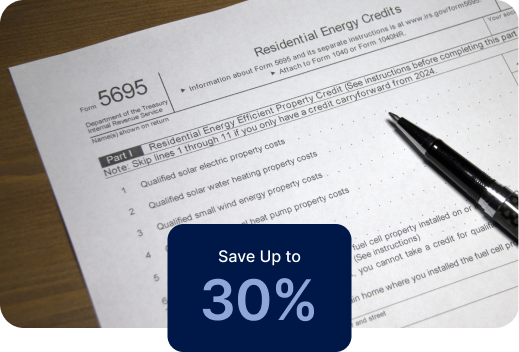The renewable energy sector continues to expand, despite policy uncertainty under the Trump administration.
South Carolina Solar Incentives: 2025 Overview
South Carolina offers valuable incentives to make solar energy affordable. Homeowners can benefit from the 30% Residential Clean Energy Credit and an additional state tax credit, significantly reducing installation costs. The state’s net metering program allows residents to earn credits for excess energy, lowering future bills. Going solar in South Carolina is a smart choice…

Residential Clean Energy Credit
The Clean Electricity Investment Credit (previously called the Federal Investment Tax Credit) helps lower the cost of installing solar panels by 30%. This credit covers everything: the solar panels, equipment, labor, permits, and even sales tax.
For example, as of 2025 the average cost of a 10 kW solar system in the U.S. typically ranges between $21,000 and $29,500 before applying any federal tax incentives. After claiming the 30% Clean Electricity Investment Credit, the price drops to around $14,980 to $21,070, depending on the state and other factors like equipment quality and labor costs.
To claim this credit, you must buy your solar system with cash or a loan (leases don’t qualify). You also need to owe enough in taxes to claim the credit, but if you don’t, you can carry it over to future years until 2034.

Claiming the Clean Electricity Investment Credit is simple!
Step 1
Print IRS Form 3468
Step 2
Fill out the form using info from your installer
Step 3
Submit it when you file your taxes
What are the top solar incentives in South Carolina?
Besides the Clean Electricity Investment Credit (former ITC), homeowners can take advantage of several outstanding incentives that significantly enhance the return on investment for solar panels. Here are some of the most effective ways to lower your solar installation costs.
Incentive
Savings
Summary
SC Solar Energy System Credit
Code Section 12-6-3587 provides a corporate or individual tax credit of 25% of the costs incurred by a taxpayer in the purchase and installation of a solar energy system or small hydropower system for heating water, space heating, air cooling, energy-efficient daylighting, heat reclamation, energy-efficient demand response, or the generation of electricity in or on a facility in South Carolina and owned by the taxpayer. The taxpayer may not claim the credit before installation is complete. The amount of the credit in any year may not exceed $3,500 for each facility or 50% of the taxpayer’s tax liability for that tax year, whichever is less. If the amount of the credit exceeds $3,500 for each facility, the taxpayer may carry forward the excess for up to 10 years.
Residential Renewable Energy Tax Credit
Established by The Energy Policy Act of 2005, the federal tax credit for residential energy property initially applied to solar-electric systems, solar water heating systems and fuel cells. A taxpayer may claim a credit of 30% of qualified expenditures for a system that serves a dwelling unit located in the United States that is owned and used as a residence by the taxpayer. Expenditures with respect to the equipment are treated as made when the installation is completed. If the installation is at a new home, the “placed in service” date is the date of occupancy by the homeowner. Expenditures include labor costs for on-site preparation, assembly or original system installation, and for piping or wiring to interconnect a system to the home. If the federal tax credit exceeds tax liability, the excess amount may be carried forward to the succeeding taxable year. The excess credit may be carried forward until 2016, but it is unclear whether the unused tax credit can be carried forward after then.
Customer Scale Solar Program – 0 MW to 2.5 MW (Closed)
SCE&G offers incentives for residential customers and nonresidential customers. Incentives are limited to approximately 42 megawatts (MW) of installed capacity, with 33 MW for distributed systems under 1 MW and 9 MW for systems under 20 kilowatts (kW). The performance based incentive (PBI) for residential systems under 20 kW are as follows: 0 MW to 2.5 MW cumulative capacity: 4 cents per kilowatt hour, 2.5 MW to 5 MW cumulative capacity: 3 cents per kilowatt hour, 5 to 7 MW cumulative capacity: 2 cents per kilowatt hour, 7 to 9 MW cumulative capacity: 1 cent per kilowatt hour. The PBI residential incentive is retroactively available for systems installed after January 1, 2015 for all customers who join the new Net Metering tariff. At the discretion of the customer, some incentives may be claimed by the customer or applied to companies installing or leasing systems.
Customer Scale Solar Program – 2.5 MW to 5 MW (Closed)
SCE&G offers incentives for residential customers and nonresidential customers. Incentives are limited to approximately 42 megawatts (MW) of installed capacity, with 33 MW for distributed systems under 1 MW and 9 MW for systems under 20 kilowatts (kW). The performance based incentive (PBI) for residential systems under 20 kW are as follows: 0 MW to 2.5 MW cumulative capacity: 4 cents per kilowatt hour, 2.5 MW to 5 MW cumulative capacity: 3 cents per kilowatt hour, 5 to 7 MW cumulative capacity: 2 cents per kilowatt hour, 7 to 9 MW cumulative capacity: 1 cent per kilowatt hour. The PBI residential incentive is retroactively available for systems installed after January 1, 2015 for all customers who join the new Net Metering tariff. At the discretion of the customer, some incentives may be claimed by the customer or applied to companies installing or leasing systems.
Customer Scale Solar Program – 7 to 9 MW (Closed)
SCE&G offers incentives for residential customers and nonresidential customers. Incentives are limited to approximately 42 megawatts (MW) of installed capacity, with 33 MW for distributed systems under 1 MW and 9 MW for systems under 20 kilowatts (kW). The performance based incentive (PBI) for residential systems under 20 kW are as follows: 0 MW to 2.5 MW cumulative capacity: 4 cents per kilowatt hour, 2.5 MW to 5 MW cumulative capacity: 3 cents per kilowatt hour, 5 to 7 MW cumulative capacity: 2 cents per kilowatt hour, 7 to 9 MW cumulative capacity: 1 cent per kilowatt hour. The PBI residential incentive is retroactively available for systems installed after January 1, 2015 for all customers who join the new Net Metering tariff. At the discretion of the customer, some incentives may be claimed by the customer or applied to companies installing or leasing systems.
Customer Scale Solar Program – 5 to 7 MW (Closed)
SCE&G offers incentives for residential customers and nonresidential customers. Incentives are limited to approximately 42 megawatts (MW) of installed capacity, with 33 MW for distributed systems under 1 MW and 9 MW for systems under 20 kilowatts (kW). The performance based incentive (PBI) for residential systems under 20 kW are as follows: 0 MW to 2.5 MW cumulative capacity: 4 cents per kilowatt hour, 2.5 MW to 5 MW cumulative capacity: 3 cents per kilowatt hour, 5 to 7 MW cumulative capacity: 2 cents per kilowatt hour, 7 to 9 MW cumulative capacity: 1 cent per kilowatt hour. The PBI residential incentive is retroactively available for systems installed after January 1, 2015 for all customers who join the new Net Metering tariff. At the discretion of the customer, some incentives may be claimed by the customer or applied to companies installing or leasing systems.
Residential Renewable Energy Tax Credit
A taxpayer may claim a credit of 26% of qualified expenditures, after deducting incentives, with no upper limit for a system that serves a dwelling unit located in the United States that is owned and used as a residence by the taxpayer. Expenditures with respect to the equipment are treated as made when the installation is completed. If the installation is at a new home, the “placed in service” date is the date of occupancy by the homeowner. Expenditures include labor costs for on-site preparation, assembly or original system installation, and for piping or wiring to interconnect a system to the home. If the federal tax credit exceeds tax liability, the excess amount may be carried forward to the succeeding taxable year. The excess credit may be carried forward until 2019, but it is unclear whether the unused tax credit can be carried forward after then.
Residential Renewable Energy Tax Credit
A taxpayer may claim a credit of 22% of qualified expenditures, after deducting incentives, with no upper limit for a system that serves a dwelling unit located in the United States that is owned and used as a residence by the taxpayer. Expenditures with respect to the equipment are treated as made when the installation is completed. If the installation is at a new home, the “placed in service” date is the date of occupancy by the homeowner. Expenditures include labor costs for on-site preparation, assembly or original system installation, and for piping or wiring to interconnect a system to the home. If the federal tax credit exceeds tax liability, the excess amount may be carried forward to the succeeding taxable year. The excess credit may be carried forward until 2019, but it is unclear whether the unused tax credit can be carried forward after then.
Residential Renewable Energy Tax Credit
A taxpayer may claim a credit of 30% for the installation which was between 2022-2032 (Systems installed on or before December 31, 2019 were also eligible for a 30% tax credit), with no upper limit for a system that serves a dwelling unit located in the United States that is owned and used as a residence by the taxpayer. Expenditures with respect to the equipment are treated as made when the installation is completed. If the installation is at a new home, the placed in service date is the date of occupancy by the homeowner. Expenditures include labor costs for on-site preparation, assembly or original system installation, and for piping or wiring to interconnect a system to the home.
Sunsense Solar PV Program
This program is part of Duke Energy’s ongoing commitment to making renewable energy more accessible and affordable for customers and communities. With solar photovoltaic (PV) panels on your rooftop, you could be generating clean, renewable electricity and incentives from Duke Energy Progress. The incentive is multifaceted. Customers will receive an upfront payment of $250 for every kilowatt-AC (kW-AC) they install on their home, and they will receive monthly credits on their bill of $4.50 per kW-AC. For instance, if a customer installs a 10 kW-AC system, the largest system eligible to participate in the program, the customer will receive a check for $2500 plus a bill credit of $45 on their monthly bills. To participate in the program, the customer must surrender all their Renewable Energy Credits (RECs*) to Duke Energy Progress for a period of five years and they will receive the $4.50 per kW bill credits throughout those five years.
Residential Solar Rebate
Duke Energy Progress is committed to bringing more energy solutions for our South Carolina customers. Offering a solar incentive to help lower your upfront, installation costs. The incentive is being offered on a first-come, first-serve basis. The current rebate value is $1 per watt – DC. This value is subject to change.
Solar Home Rebate Program
Santee Cooper is pleased to offer its 2017 Solar Home Program. The Solar Home Program provides rebates to eligible residential Customers for the installation of solar photovoltaic (PV) systems for electric generation at their homes. It provides rebates to residential Customers who subscribe to the Santee Cooper sponsored community share solar farm located inColleton, SC (“Solar Farm”). Rebates for the installation of solar PV systems are set as a one-time payment of $1.60/watt paid based on the system’s power output (watt AC). Solar Home Rebates are capped at $9,600 per account number.
Solar Home Rebate Program
Santee Cooper is pleased to offer its 2017 Solar Home Program. The Solar Home Program provides rebates to eligible residential Customers for the installation of solar photovoltaic (PV) systems for electric generation at their homes. It provides rebates to residential Customers who subscribe to the Santee Cooper sponsored community share solar farm located inColleton, SC (“Solar Farm”). Rebates for the installation of solar PV systems are set as a one-time payment of $1.60/watt paid based on the system’s power output (watt AC). Solar Home Rebates are capped at $9,600 per account number.
Solar Home Rebate Program
Santee Cooper is pleased to offer its 2019 Solar Home Program. The Solar Home Program provides rebates to eligible residential Customers for the installation of solar photovoltaic (PV) systems for electric generation at their homes. It provides rebates to residential Customers who subscribe to the Santee Cooper sponsored community share solar farm located inColleton, SC (“Solar Farm”). Rebates for the installation of solar PV systems are set as a one-time payment of $1.20/watt paid based on the system’s power output (watt AC). Solar Home Rebates are capped at 6 kW AC per meter base.
Solar Home Rebate Program
Santee Cooper is pleased to offer its 2021 Solar Home Program. The Solar Home Program provides rebates to eligible residential Customers for the installation of solar photovoltaic (PV) systems for electric generation at their homes. It provides rebates to residential Customers who subscribe to the Santee Cooper sponsored community share solar farm located in Colleton, SC (“Solar Farm”). Rebates for the installation of solar PV systems are set as a one-time payment of $1.05/watt paid based on the system’s power output (watt AC). Solar Home Rebates are capped at 6 kW AC per meter base.
Solar Home Rebate Program
Santee Cooper is pleased to offer its 2023 Solar Home Program. The Solar Home Program provides rebates to eligible residential Customers for the installation of solar photovoltaic (PV) systems for electric generation at their homes. It provides rebates to residential Customers who subscribe to the Santee Cooper sponsored community share solar farm located in Colleton, SC (“Solar Farm”). Rebates for the installation of solar PV systems are set as a one-time payment of $0.95/watt paid based on the system’s power output (watt AC). Solar Home Rebates are capped at 6 kW AC per meter base.
Disclaimer: The information provided here regarding solar incentives, tax credits, and rebates is for general informational purposes only and may vary based on your specific circumstances. For exact details, eligibility requirements, and current rates, we recommend consulting a certified solar installer or a tax professional. Incentives can differ by location, utility provider, and individual project, so it’s important to get personalized advice for your solar installation. Always verify the most up-to-date information from your local solar installer to understand how these incentives apply to your project.
Knowledge Base
Find everything you need to know about solar in your state and nationwide

Get a Quote
Discover the Ideal Solar System for Your Home in Just a Few Clicks!







